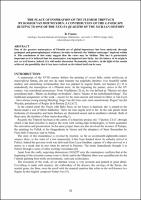Chapter The Place of Inspiration of the Flemish Triptych by Rogier van der Weyden. A Contribution of the landscape busting to one of the vexata quaestio of the Sicilian History
| dc.contributor.author | Franco, Roberto | |
| dc.date.accessioned | 2022-06-01T12:08:33Z | |
| dc.date.available | 2022-06-01T12:08:33Z | |
| dc.date.issued | 2018 | |
| dc.identifier | ONIX_20220601_9788864537078_98 | |
| dc.identifier.issn | 2704-5846 | |
| dc.identifier.uri | https://library.oapen.org/handle/20.500.12657/55915 | |
| dc.description.abstract | One of the greatest masterpieces of Flemish art of global importance has been analyzed, through geological and geomorphological evidence, in order to identify the ‘hidden landscapes’ depicted within it. The conclusions of this study suggest that the views may be Sicilian. This fact is particularly important as it is believed that the masterpiece was imported into Sicily, but the history of its origin is not yet well known, indeed, it is still under discussion. Reasonably, therefore, in the light of the results achieved, the possibility that it has been realized on the island itself can be seen. | |
| dc.language | English | |
| dc.relation.ispartofseries | Proceedings e report | |
| dc.subject.other | Hidden Landscapes | |
| dc.subject.other | Flemish Artist | |
| dc.subject.other | Landscape Busting | |
| dc.title | Chapter The Place of Inspiration of the Flemish Triptych by Rogier van der Weyden. A Contribution of the landscape busting to one of the vexata quaestio of the Sicilian History | |
| dc.type | chapter | |
| oapen.identifier.doi | 10.36253/978-88-6453-707-8.17 | |
| oapen.relation.isPublishedBy | bf65d21a-78e5-4ba2-983a-dbfa90962870 | |
| oapen.relation.isbn | 9788864537078 | |
| oapen.series.number | 118 | |
| oapen.pages | 6 | |
| oapen.place.publication | Florence |

